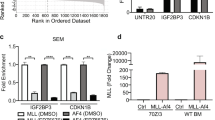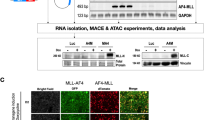Abstract
MLL rearranged acute lymphoblastic leukemia (MLL) is an aggressive type of acute lymphoblastic leukemia (ALL), diagnosed predominantly in infants (<1 years of age). Since current chemotherapy fails in >50% of patients with MLL, new therapeutic strategies are desperately needed. For this, understanding the biological features characterizing MLL is necessary. Analysis of gene expression profiles revealed that the expression of the tumor suppressor gene FHIT is reduced in children with MLL rearranged ALL as compared to ALL patients carrying germ line MLL. This finding was confirmed by quantitative real-time PCR. In 100% of the infant MLL cases tested, methylation of the FHIT 5′CpG region was observed, resulting in strongly reduced mRNA and protein expression. In contrast, FHIT methylation in infant and non-infant ALL patients carrying germ line MLL was found in only ∼60% (P⩽0.004). FHIT expression was restored upon exposing leukemic cells to the demethylating agent decitabine, which induced apoptosis. Likewise and more specifically, leukemic cell death was induced by transfecting MLL rearranged leukemic cells with expression vectors encoding wild-type FHIT, confirming tumor suppressor activity of this gene. These observations imply that suppression of FHIT may be required for the development of MLL, and provide new insights into leukemogenesis and therapeutic possibilities for MLL.
This is a preview of subscription content, access via your institution
Access options
Subscribe to this journal
Receive 12 print issues and online access
$259.00 per year
only $21.58 per issue
Buy this article
- Purchase on Springer Link
- Instant access to full article PDF
Prices may be subject to local taxes which are calculated during checkout








Similar content being viewed by others
References
Pui CH, Kane JR, Crist WM . Biology and treatment of infant leukemias. Leukemia 1995; 9: 762–769.
Greaves MF . Infant leukaemia biology, aetiology and treatment. Leukemia 1996; 10: 372–377.
Pieters R, den Boer ML, Durian M, Janka G, Schmiegelow K, Kaspers GJ et al. Relation between age, immunophenotype and in vitro drug resistance in 395 children with acute lymphoblastic leukemia – implications for treatment of infants. Leukemia 1998; 12: 1344–1348.
Biondi A, Cimino G, Pieters R, Pui CH . Biological and therapeutic aspects of infant leukemia. Blood 2000; 96: 24–33.
Ramakers-van Woerden NL, Beverloo HB, Veerman AJ, Camitta BM, Loonen AH, van Wering ER et al. In vitro drug-resistance profile in infant acute lymphoblastic leukemia in relation to age, MLL rearrangements and immunophenotype. Leukemia 2004; 18: 521–529.
Taki T, Ida K, Bessho F, Hanada R, Kikuchi A, Yamamoto K et al. Frequency and clinical significance of the MLL gene rearrangements in infant acute leukemia. Leukemia 1996; 10: 1303–1307.
Chen CS, Sorensen PH, Domer PH, Reaman GH, Korsmeyer SJ, Heerema NA et al. Molecular rearrangements on chromosome 11q23 predominate in infant acute lymphoblastic leukemia and are associated with specific biologic variables and poor outcome. Blood 1993; 81: 2386–2393.
Armstrong SA, Staunton JE, Silverman LB, Pieters R, den Boer ML, Minden MD et al. MLL translocations specify a distinct gene expression profile that distinguishes a unique leukemia. Nat Genet 2002; 30: 41–47.
Armstrong SA, Golub TR, Korsmeyer SJ . MLL-rearranged leukemias: insights from gene expression profiling. Semin Hematol 2003; 40: 268–273.
Armstrong SA, Kung AL, Mabon ME, Silverman LB, Stam RW, Den Boer ML et al. Inhibition of FLT3 in MLL. Validation of a therapeutic target identified by gene expression based classification. Cancer Cell 2003; 3: 173–183.
Ohta M, Inoue H, Cotticelli MG, Kastury K, Baffa R, Palazzo J et al. The FHIT gene, spanning the chromosome 3p14.2 fragile site and renal carcinoma-associated t(3;8) breakpoint, is abnormal in digestive tract cancers. Cell 1996; 84: 587–597.
Barnes LD, Garrison PN, Siprashvili Z, Guranowski A, Robinson AK, Ingram SW et al. Fhit, a putative tumor suppressor in humans, is a dinucleoside 5′,5″′-P1,P3-triphosphate hydrolase. Biochemistry 1996; 35: 11529–11535.
Siprashvili Z, Sozzi G, Barnes LD, McCue P, Robinson AK, Eryomin V et al. Replacement of Fhit in cancer cells suppresses tumorigenicity. Proc Natl Acad Sci USA 1997; 94: 13771–13776.
Roz L, Gramegna M, Ishii H, Croce CM, Sozzi G . Restoration of fragile histidine triad (FHIT) expression induces apoptosis and suppresses tumorigenicity in lung and cervical cancer cell lines. Proc Natl Acad Sci USA 2002; 99: 3615–3620.
Sevignani C, Calin GA, Cesari R, Sarti M, Ishii H, Yendamuri S et al. Restoration of fragile histidine triad (FHIT) expression induces apoptosis and suppresses tumorigenicity in breast cancer cell lines. Cancer Res 2003; 63: 1183–1187.
Dumon KR, Ishii H, Fong LY, Zanesi N, Fidanza V, Mancini R et al. FHIT gene therapy prevents tumor development in Fhit-deficient mice. Proc Natl Acad Sci USA 2001; 98: 3346–3351.
Ishii H, Dumon KR, Vecchione A, Fong LY, Baffa R, Huebner K et al. Potential cancer therapy with the fragile histidine triad gene: review of the preclinical studies. JAMA 2001; 286: 2441–2449.
Krivak TC, McBroom JW, Seidman J, Venzon D, Crothers B, MacKoul PJ et al. Abnormal fragile histidine triad (FHIT) expression in advanced cervical carcinoma: a poor prognostic factor. Cancer Res 2001; 61: 4382–4385.
Takizawa S, Nakagawa S, Nakagawa K, Yasugi T, Fujii T, Kugu K et al. Abnormal Fhit expression is an independent poor prognostic factor for cervical cancer. Br J Cancer 2003; 88: 1213–1216.
Rocco A, Schandl L, Chen J, Wang H, Tulassay Z, McNamara D et al. Loss of FHIT protein expression correlates with disease progression and poor differentiation in gastric cancer. J Cancer Res Clin Oncol 2003; 129: 84–88.
Albitar M, Manshouri T, Gidel C, Croce C, Kornblau S, Pierce S et al. Clinical significance of fragile histidine triad gene expression in adult acute lymphoblastic leukemia. Leuk Res 2001; 25: 859–864.
Kantarjian HM, Talpaz M, O'Brien S, Manshouri T, Cortes J, Giles F et al. Significance of FHIT expression in chronic myelogenous leukemia. Clin Cancer Res 1999; 5: 4059–4064.
Zheng S, Ma X, Zhang L, Gunn L, Smith MT, Wiemels JL et al. Hypermethylation of the 5' CpG island of the FHIT gene is associated with hyperdiploid and translocation-negative subtypes of pediatric leukemia. Cancer Res 2004; 64: 2000–2006.
Kaspers GJ, Veerman AJ, Pieters R, Broekema GJ, Huismans DR, Kazemier KM et al. Mononuclear cells contaminating acute lymphoblastic leukaemic samples tested for cellular drug resistance using the methyl-thiazol-tetrazolium assay. Br J Cancer 1994; 70: 1047–1052.
Stam RW, den Boer ML, Meijerink JP, Ebus ME, Peters GJ, Noordhuis P et al. Differential mRNA expression of Ara-C-metabolizing enzymes explains Ara-C sensitivity in MLL gene-rearranged infant acute lymphoblastic leukemia. Blood 2003; 101: 1270–1276.
Zochbauer-Muller S, Fong KM, Maitra A, Lam S, Geradts J, Ashfaq R et al. 5' CpG island methylation of the FHIT gene is correlated with loss of gene expression in lung and breast cancer. Cancer Res 2001; 61: 3581–3585.
Pekarsky Y, Zanesi N, Palamarchuk A, Huebner K, Croce CM . FHIT: from gene discovery to cancer treatment and prevention. Lancet Oncol 2002; 3: 748–754.
Rozovskaia T, Ravid-Amir O, Tillib S, Getz G, Feinstein E, Agrawal H et al. Expression profiles of acute lymphoblastic and myeloblastic leukemias with ALL-1 rearrangements. Proc Natl Acad Sci USA 2003; 100: 7853–7858.
Gutierrez MI, Siraj AK, Bhargava M, Ozbek U, Banavali S, Chaudhary MA et al. Concurrent methylation of multiple genes in childhood ALL: Correlation with phenotype and molecular subgroup. Leukemia 2003; 17: 1845–1850.
Greaves MF . Speculations on the cause of childhood acute lymphoblastic leukemia. Leukemia 1988; 2: 120–125.
Gale KB, Ford AM, Repp R, Borkhardt A, Keller C, Eden OB et al. Backtracking leukemia to birth: identification of clonotypic gene fusion sequences in neonatal blood spots. Proc Natl Acad Sci USA 1997; 94: 13950–13954.
Taketani T, Taki T, Sugita K, Furuichi Y, Ishii E, Hanada R et al. FLT3 mutations in the activation loop of tyrosine kinase domain are frequently found in infant ALL with MLL rearrangements and pediatric ALL with hyperdiploidy. Blood 2004; 103: 1085–1088.
Stam RW, den Boer ML, Schneider P, Nollau P, Horstmann M, Beverloo HB et al. Targeting FLT3 in primary MLL gene rearranged infant acute lymphoblastic leukemia. Blood 2005.
Popescu NC . Genetic alterations in cancer as a result of breakage at fragile sites. Cancer Lett 2003; 192: 1–17.
Shu XO, Ross JA, Pendergrass TW, Reaman GH, Lampkin B, Robison LL . Parental alcohol consumption, cigarette smoking, and risk of infant leukemia: a Childrens Cancer Group study. J Natl Cancer Inst 1996; 88: 24–31.
Brondum J, Shu XO, Steinbuch M, Severson RK, Potter JD, Robison LL . Parental cigarette smoking and the risk of acute leukemia in children. Cancer 1999; 85: 1380–1388.
Di Croce L, Raker VA, Corsaro M, Fazi F, Fanelli M, Faretta M et al. Methyltransferase recruitment and DNA hypermethylation of target promoters by an oncogenic transcription factor. Science 2002; 295: 1079–1082.
Huret JL, Dessen P, Bernheim A . An atlas of chromosomes in hematological malignancies. Example: 11q23 and MLL partners. Leukemia 2001; 15: 987–989.
Birke M, Schreiner S, Garcia-Cuellar MP, Mahr K, Titgemeyer F, Slany RK . The MT domain of the proto-oncoprotein MLL binds to CpG-containing DNA and discriminates against methylation. Nucleic Acids Res 2002; 30: 958–965.
Ayton PM, Chen EH, Cleary ML . Binding to nonmethylated CpG DNA is essential for target recognition, transactivation, and myeloid transformation by an MLL oncoprotein. Mol Cell Biol 2004; 24: 10470–10478.
Acknowledgements
We wish to express our gratitude to the members and participating hospitals of the INTERFANT-99 for supporting this study by providing leukemic samples. Members of INTERFANT-99 are: Campbell M (PINDA), Felice M (Argentina), Ferster A (CLCG), Hann I and Vora A (UKCCSG), Hovi L (NOPHO), Janka-Schaub G (COALL), Li CK (Hong Kong), Mann G (BFM-A), Mechinaud F (FRALLE), Pieters R (DCOG), de Rossi G and Biondi A (AIEOP), Rubnitz J (SJCRH), Schrappe M (BFM-G), Silverman L (DFCI), Stary J (CPH), Suppiah R (ANZCHOG), Szczepanski T (PPLLSG), Valscecchi M and de Lorzenzo P (CORS).
Author information
Authors and Affiliations
Corresponding author
Additional information
Financial support: This study was supported by a grant from the Sophia Foundation for Medical Research (SSWO Grant 296)
Rights and permissions
About this article
Cite this article
Stam, R., den Boer, M., Passier, M. et al. Silencing of the tumor suppressor gene FHIT is highly characteristic for MLL gene rearranged infant acute lymphoblastic leukemia. Leukemia 20, 264–271 (2006). https://doi.org/10.1038/sj.leu.2404074
Received:
Revised:
Accepted:
Published:
Issue Date:
DOI: https://doi.org/10.1038/sj.leu.2404074
Keywords
This article is cited by
-
Germinal epimutation of Fragile Histidine Triad (FHIT) gene is associated with progression to acute and chronic adult T-cell leukemia diseases
Molecular Cancer (2021)
-
Elevated S100A8/S100A9 expression causes glucocorticoid resistance in MLL-rearranged infant acute lymphoblastic leukemia
Leukemia (2012)
-
Fragile histidine triad protein: structure, function, and its association with tumorogenesis
Journal of Cancer Research and Clinical Oncology (2010)
-
Infant acute lymphoblastic leukemia: Lessons learned and future directions
Current Hematologic Malignancy Reports (2009)
-
New therapeutic strategies for the treatment of acute lymphoblastic leukaemia
Nature Reviews Drug Discovery (2007)



